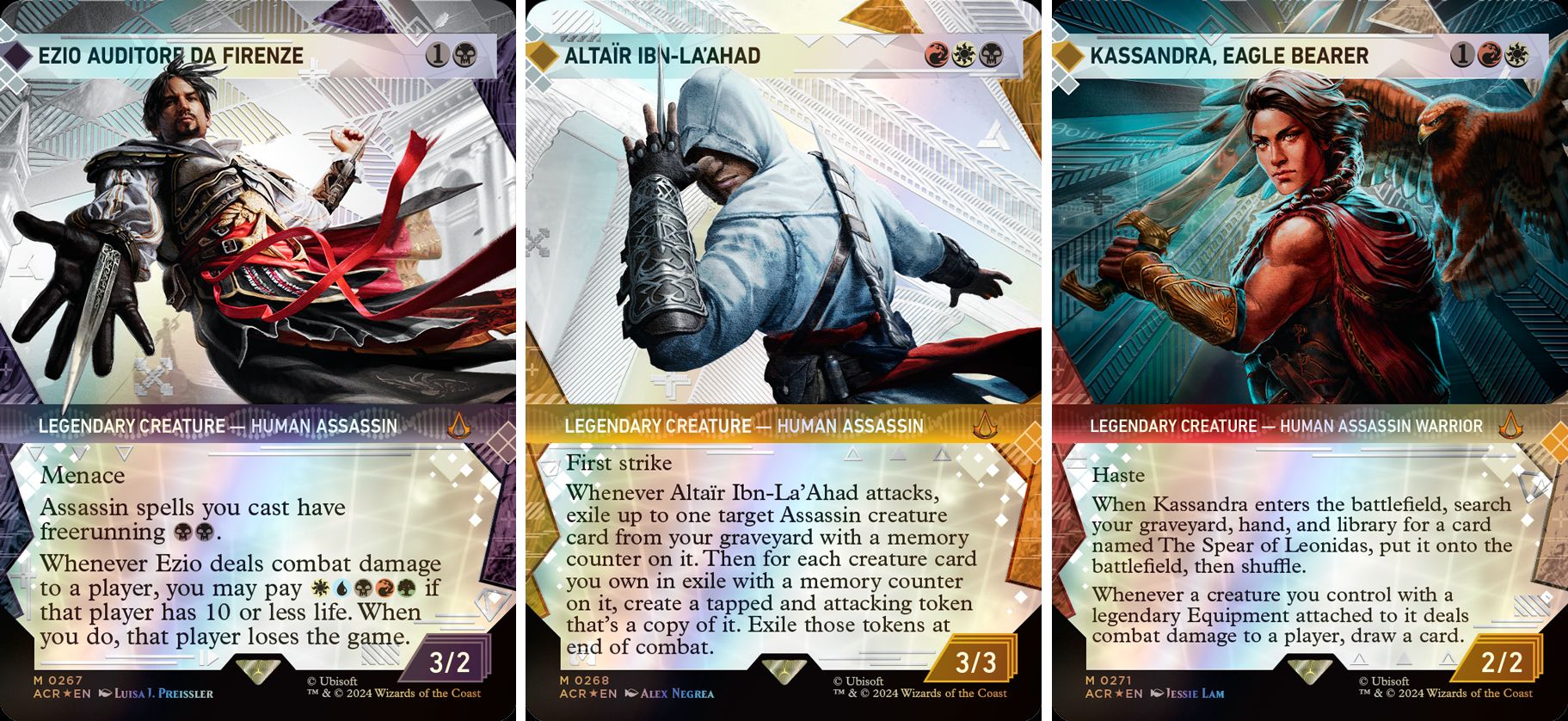Magic’s videogame crossovers continue to not suck
Way back in 2008, the Morningtide set introduced a mechanic called Prowl. It let you play cards with the creature type Rogue for less mana if you’d damaged another player (rather than their creatures) earlier that turn. The Assassin’s Creed crossover brings Prowl back, only renamed Freerunning and with its reduced cost applied to the Assassin creature type instead. That means if I can sneak even a single point of damage past an opponents’ defenses, I can bring down a whole gang of bargain bonus Brotherhood buddies immediately after.
I do this by playing the Hookblade Veteran, who has a zipline that means he counts as flying on my turn and can bypass most defenses. One of my opponents does have something that can block flying attackers—a Towering Viewpoint, which has the flight-blocking keyword Reach—so first I make sure to take that out with a Poison-Blade Mentor. How do I poison a tower to death? Must be Animus magic. Like that one Assassin’s Creed Origins DLC where you visit the literal afterlife, It’s best not to question these things.
By the end of the match I’ve also brought out Rooftop Bypass, which gives me a free Assassin token whenever I damage a player, and Ezio, Blade of Vengeance, who lets me draw a card for the same thing so long as an Assassin is the one doing the damage. Which they are, because my deck is chock full of them. It’s a lovely little engine I’ve built, except that I didn’t really build it, because I’m playing a pre-constructed deck.
While booster packs are available, the Assassin’s Creed crossover also comes in a starter kit with two 60-card decks. One is themed around Eivor from Assassin’s Creed Valhalla, a videogame I haven’t played because it’s like 100 hours long and honestly the AssCreed games start to feel like butter spread over too much toast by the time they hit 50 hours. I’m sticking with the Ezio-themed starter deck instead, which I suspect will be a popular choice.
It’s tempting to build a deck around a different theme, though. With cards like Jackdaw, Edward Kenway, Coastal Piracy, Ballad of the Black Flag, Mary Read and Anne Bonny, and Adéwalé, Breaker of Chains, you’ve got the beginnings of a pirate deck, but I could also see an every-color historical characters deck built around figures like Cleopatra, Leonardo, and Sokrates. Or a tweaked version of this Freerunning Assassin deck that’s built around Evie and Jacob Frye rather than Ezio.
The latter two characters are depicted on a couple of my favorite cards, at least in terms of the art. Evie is shown sneaking along a railing above a train station, with Jacob visible down on the platform getting into a fistfight. Jacob’s card shows the same brawl from ground level, and if you look closely beyond the smoke above him you can see Evie’s silhouette in the corner. Meanwhile, the card showing Ezio synchronizing on a rooftop lines up with a bunch of other cards to form the skyline of Rome, while some of the historical figures come in alternate versions printed in their native language.

These cute touches and displays of attention to detail, as well as the frankly gorgeous art, keep me feeling positive about these videogame crossovers. While the Fallout set’s Commander decks were a personal favorite, the Assassin’s Creed cards are still fun to try out and, in the Ezio deck, tightly themed around murdering people from rooftops—which is all I want. It’s left me feeling hopeful for the upcoming Final Fantasy crossover, since the official Final Fantasy card game is a bit of a dud.
So far, Magic’s dips into videogame territory have worn the clothes of their new settings well enough to blend in seamlessly. Given the choice between these and the endless licensed CCGs of the late ’90s that used to rip off Magic without being nearly as good, I’d rather have more of these professionally designed and slickly produced official crossovers.
Assassin’s Creed x Magic: The Gathering is available now.
Source link




